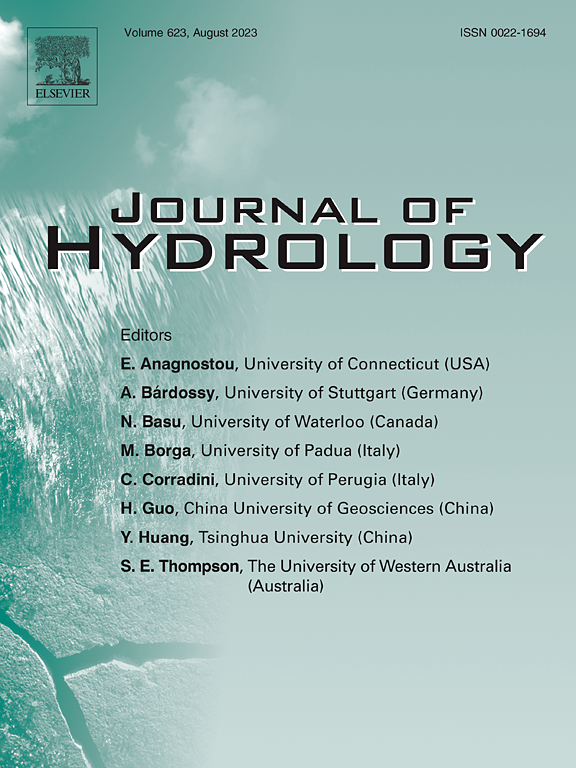复合极端干旱对中国植被生产力的影响越来越大
IF 5.9
1区 地球科学
Q1 ENGINEERING, CIVIL
引用次数: 0
摘要
全球变化加剧导致大气和土壤干旱事件频发,对全球生态系统构成严重威胁。虽然土壤干旱(以土壤水分为特征)和大气干旱(以水汽压亏缺为特征)经常同时发生,但它们的联合效应很少被量化为复合干旱。本研究将观测数据和CMIP6耦合模式比对项目(CMIP6)模拟结合相关分析、copula模型和机器学习研究复合极端干旱的发生和影响。研究结果表明,土壤极端干旱和大气极端干旱同步发生的频率高于单个极端事件的预期,土壤极端干旱和大气极端干旱同步发生的频率高于单个极端事件的预期。与历史模拟(1920-1999)(- 0.22 gC·m−2·day−1)相比,未来模拟(2021-2100)(SSP126:-0.26 gC·m−2·day−1)预测复合极端干旱对总初级生产力(GPP)的影响更为严重;SSP370:-0.33 gC·m−2·day−1),对半干旱区的影响尤为显著。复合干旱胁迫对GPP的影响在不同植被类型和气候干旱梯度上存在显著差异。随着碳排放情景的增加,CO2成为复合干旱胁迫下植被生产力的重要调控因子。极端土壤干旱对GPP的负面影响强度和空间程度远超极端大气干旱,表明极端干旱胁迫下SM对植被生产力的影响更为关键。这些发现强调了极端干旱事件削弱植被固碳的证据,为准确评估气候变化情景下中国植被与气候的相互作用提供了重要的见解。本文章由计算机程序翻译,如有差异,请以英文原文为准。

Increasing impacts of compound extreme droughts on vegetation productivity in China
The intensification of global change has led to frequent atmospheric and soil drought events, posing severe threats to global ecosystems. Although soil drought (characterized by soil moisture, SM) and atmospheric drought (characterized by vapor pressure deficit, VPD) often co-occur, their combined effects are rarely quantified as compound droughts. This study integrates observational data and Coupled Model Intercomparison Project Phase 6 (CMIP6) simulations with correlation analysis, copula models, and machine learning to investigate the occurrence and impacts of compound extreme droughts. Our findings reveal that SM and VPD exhibit bimodal distributions, with synchronized extreme soil droughts and extreme atmospheric droughts occurring more frequently than expected from individual extreme events. Compared to the historical simulations (1920–1999) (−0.22 gC·m−2·day−1), the impact of compound extreme droughts on gross primary productivity (GPP) are projected to be more severe in the future simulations (2021–2100) (SSP126:-0.26 gC·m−2·day−1; SSP370:-0.33 gC·m−2·day−1), with particularly pronounced impacts in semi-arid regions. The compound drought stress on GPP exhibits significant variations across vegetation types and along the climatic aridity gradient. With increasing carbon emission scenarios, CO2 becomes a crucial regulatory factor in compound drought stress on vegetation productivity. The negative impact intensity and spatial extent of extreme soil drought on GPP far exceed those of extreme atmospheric drought, indicating that SM will play a more critical role in extreme drought stress on vegetation productivity. These findings highlight evidence that extreme drought events weaken vegetation carbon sequestration, providing essential insights for accurately assessing the interactions between vegetation and climate in China under climate change scenarios.
求助全文
通过发布文献求助,成功后即可免费获取论文全文。
去求助
来源期刊

Journal of Hydrology
地学-地球科学综合
CiteScore
11.00
自引率
12.50%
发文量
1309
审稿时长
7.5 months
期刊介绍:
The Journal of Hydrology publishes original research papers and comprehensive reviews in all the subfields of the hydrological sciences including water based management and policy issues that impact on economics and society. These comprise, but are not limited to the physical, chemical, biogeochemical, stochastic and systems aspects of surface and groundwater hydrology, hydrometeorology and hydrogeology. Relevant topics incorporating the insights and methodologies of disciplines such as climatology, water resource systems, hydraulics, agrohydrology, geomorphology, soil science, instrumentation and remote sensing, civil and environmental engineering are included. Social science perspectives on hydrological problems such as resource and ecological economics, environmental sociology, psychology and behavioural science, management and policy analysis are also invited. Multi-and interdisciplinary analyses of hydrological problems are within scope. The science published in the Journal of Hydrology is relevant to catchment scales rather than exclusively to a local scale or site.
 求助内容:
求助内容: 应助结果提醒方式:
应助结果提醒方式:


